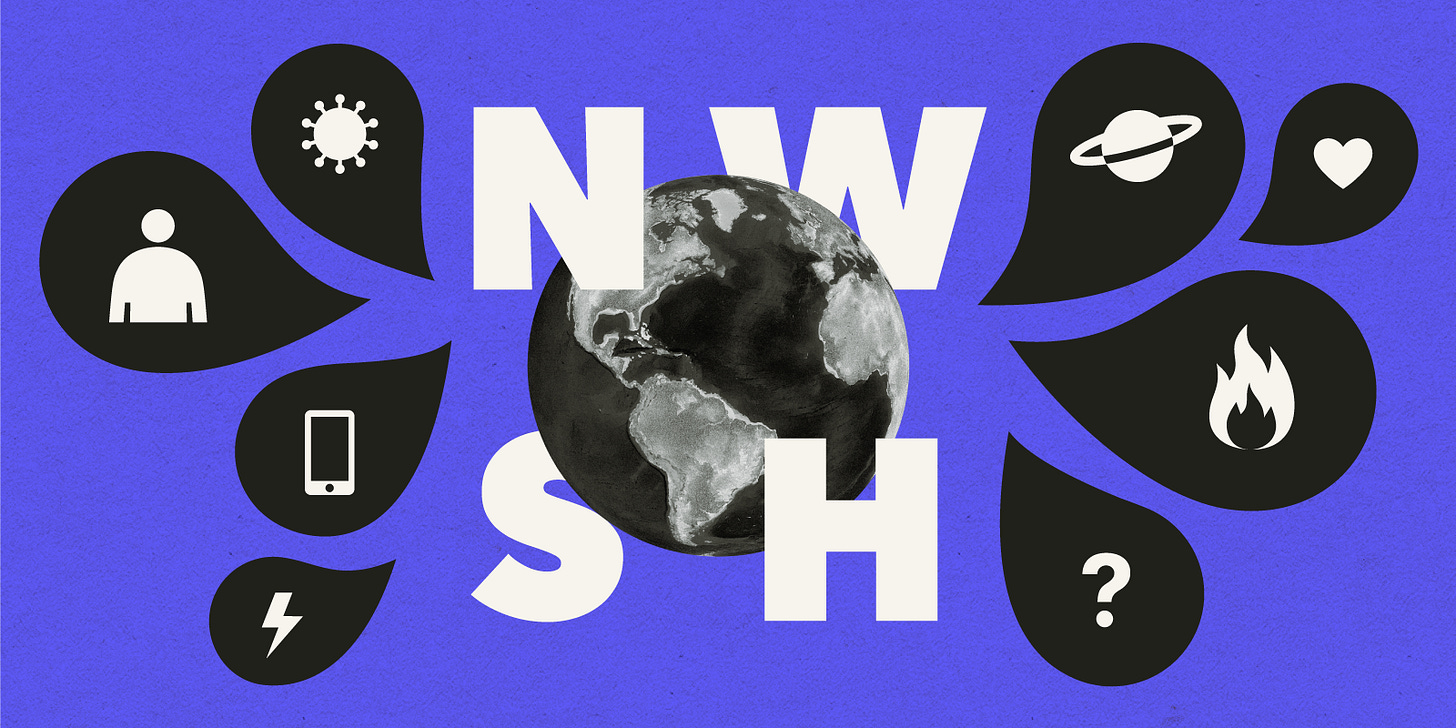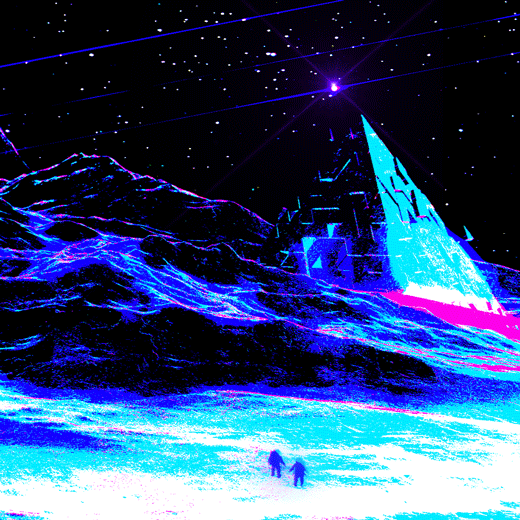Welcome to the mid-week update from New World Same Humans, a newsletter on trends, technology, and society by David Mattin.
If you’re reading this and haven’t yet subscribed, join 25,000+ curious souls on a journey to build a better future 🚀🔮
To Begin
It’s great to be back! Here, as promised, is the first post-break instalment of New Week. What do we have in store?
Nvidia are using an AI agent called Eureka to autonomously train simulated robots in virtual environments.
Meanwhile, research from Pew shows far fewer US adults are following the news; couple that with emerging deepfake technology, and 2024 should make for an interesting Presidential election year.
And a new AI model, 3D-GPT, can turn text prompts into amazing 3D worlds.
Let’s get into it.
🦾 Robot education
I’ve written often about Nvidia’s Omniverse platform: an AI-fuelled industrial metaverse that’s being used by BMW, for example, to simulate entire factories.
This week, Nvidia showcased Eureka, an autonomous AI agent that can be set loose on simulated robots and train them to perform complex tasks.
Eureka uses GPT-4 to write code that sets the simulated robots specific goals, and starts them on loops of trial and error learning. As the robot sets about its task Eureka will gather feedback and iterate its code, leading to a virtuous circle of better code and faster learning.
Via the agent, simulated robots inside Omniverse have learned to perform over 30 complex physical tasks. Including highly dextrous pen manipulation, handling of cubes, and opening doors:
Nvidia says that trial-and-error learning code generated by Eureka outperforms that created by human experts for over 80% of the tasks studied so far.
Meanwhile, Amazon this week trialled a humanoid robot called Digit in some of its US warehouses. The company says Digit could ‘free up’ warehouse staff to perform other tasks.
⚡ NWSH Take: There’s no doubt: the robots are coming. I laughed when Elon Musk announced the Tesla humanoid robot, Optimus, alongside a man dancing in a white spandex suit. Two years on, Optimus is autonomously sorting objects by hand. The pace of development has been insane. // Eureka and AI agents like it, though, have the potential to spark an explosion in robot competence. Teaching robots to navigate physical environments is hard. Now, we’ll be able to establish recursive loops of trial, error, and improvement in virtual space — no human input needed. // What could this competence explosion mean? When it comes to work, look to this week’s Amazon trial. Amazon employs 1.6 million people in its fulfilment centres worldwide, and currently it’s deploying the usual line: ‘these robots will free up staff, not replace them’. That’s hard to believe longterm; a phase of job displacement is coming, and it’s going to be painful for many. // Meanwhile, robots will make their way through workplaces and into our homes. Recently I spoke to legendary tech analyst Robert Scoble; he sees a future in which humanoid robots are delivered to homes on-demand by autonomous vehicles to vacuum, empty the dishwasher, and make the coffee. For further thoughts on that future, read Our Coming Robot Utopia.
📰 What news
This week, Pew Research gave a fascinating insight into our changing information environment.
A new survey shows that the proportion of US adults who closely follow the news has dropped precipitously across the last few years. Back in 2016, 51% of US adults said they followed the news all or most of the time. By 2022, that number had fallen to 38%.
Remarkably, the decline has taken place across all demographic lines, including age, gender, ethnicity, and voting preference.
⚡ NWSH Take: This feels like a big deal. We’re heading into a US presidential election year. And in 2024 a new set of circumstances are going to pertain. First, deepfakes are set to cause chaos as never before; just see this week’s convincing fake of Greta Thunberg in which she appears to call for ‘sustainable weaponry’. And now, via this research, we know that far fewer US voters are paying close attention to conventional sources of news. What happens to presidential campaigns in this kind of media environment? We’re going to find out. // Meanwhile, the longterm structural challenges are clear. Decades ago, the pioneers of Web 2.0 — I’m looking at you, Zuck — sold us on the idea that a connected world would mean a world informed and enlightened as never before. It hasn’t turned out that way. In fact, social media has turned many away from news as traditionally defined, and towards unverified gossip and conspiracy theory. The institutions and processes of our democracies evolved to function in symbiosis with an established media that operates under certain standards, and that is the primary source of information for voters. All that is now falling apart. Our democracies — what they are, how they work — are going to change. The 2024 presidential elections will be a window on to what is coming.
🗺 Hello world
This newsletter has watched the unfolding generative AI text-to-image revolution closely. But it’s always had one eye on another, even more compelling destination: text-to-worlds.
Now, that dream is being realised.
Researchers from the Australian National University, the University of Oxford, and the Beijing Academy of Artificial Intelligence this week showcased a new AI model called 3D-GPT. It generates 3D worlds based on natural language text prompts provided by the user.
According to the research paper, model deploys multiple AI agents to understand the text prompt and execute 3D modelling inside the open source modelling platform Blender.
See that paper for more on some of the worlds generated, including ‘A serene winter landscape, with snow covered evergreen trees and a frozen lake reflecting the pale sunlight.’
⚡ NWSH Take: 3D-GPT takes its place alongside this prototype text-to-world tool created by Blockade Labs, which I wrote about back in April. Where is all this heading? We’re still pretty deep in a metaverse winter right now, though there are signs of a thaw; the most obvious being the imminent arrival of the Apple Vision Pro mixed reality headset, which could act for millions as a gateway into more sophisticated virtual environments. While the word metaverse is probably damaged beyond repair, I still believe that immersive virtual worlds will play a role in our shared future. // What we’re talking about with text-to-world models, though, is even more head-spinning. 3D-GPT builds worlds that we look at via a screen. But eventually, we’ll be able to create entire, immersive, highly realistic VR worlds simply by describing them. In this way we’ll become something akin to sorcerers, able to confect new realities on command. That will transform video gaming and film. It will fuel new art forms and modes of collective expression. And, ultimately, it will change our relationship with reality — that is, with this reality — itself.
🗓️ Also this week
🎨 A new anti-AI tool allows artists to prevent AI models such as DALL-E from using their work as training data. Nightshade, dubbed a data poisoning tool, can be attached to creative work; if that work is scraped to be used to train an AI model, then Nightshade will corrupt the entire training database.
We’re going to see a rising number of disputes between owners of creative IP and the owners of AI models who used that work as training material. See also, this week, Universal Music Group’s lawsuit against Anthropic; UMG say Anthropic unlawfully used its song lyrics to help train the Claude AI chatbot. And now major newspapers, including the New York Times, are seeking payment from OpenAI for use of their content to help train GPT-4.
☀️ The International Energy Agency says the global shift towards renewable energy is now ‘unstoppable’. The Agency’s latest World Energy Outlook report says renewables — mainly solar and wind — will provide half the world’s electricity by 2030.
🛰 NASA’s interstellar Voyager probes had a software update beamed to them across a distance of 12 billion miles. The probes launched 46 years ago, on a mission to explore deep space. These updates are bug fixes, intended to stop Voyager 1 sending corrupted data back to mission control, and to stop gunk building up in the thrusters on both probes.
🙈 Elon Musk says he may remove X (formerly Twitter) from the EU in response to new rules that ban the spread of harmful content. The new Digital Services Act is intended to hold social media platforms accountable for fake news, false advertising, and on-platform criminal activity.
🏭 Nvidia and Foxconn say they are partnering to build a number of ‘AI factories’. They will be next-generation data centres that use Nvidia’s AI chips to train the AI models that fuel robots, autonomous vehicles, and generative AI apps.
🤖 The CEO of DeepMind, Demis Hassabis, says the risks posed by AI should be taken as seriously as those posed by climate change. Hassabis called for international regulatory oversight of AI, and said technologists should take inspiration from the International Panel on Climate Change (IPCC).
👶 A Dutch startup, Spaceborn United, wants to see if it’s possible to create human babies in space. The company says that in 2024 it will send a satellite-lab into low Earth orbit and there attempt to conduct in-vitro fertilisation (IVF). CEO Egbert Edelbroek hopes the technology can pave the way for humans to be born in future space colonies.
😳 A British journalist went undercover at Amazon and did not like what he saw. Oobah Butler found that it was possible to list bottles of Amazon delivery driver urine(!) for sale on the platform. And claims that Amazon is using devious tactics to avoid worker unionisation.
🌍 Humans of Earth
Key metrics to help you keep track of Project Human.
🙋 Global population: 8,069,001,802
🌊 Earths currently needed: 1.8454
🗓️ 2023 progress bar: 82% complete
📖 On this day: On 26 October 1977 the last human case of smallpox was diagnosed in Ali Maow Maalin, a hospital cook from Somalia. The WHO and CDC consider this date to mark the eradication of the disease via the smallpox vaccine.
Back Again
Thanks for reading this week.
The emergence of text-to-world AI models — and the future they promise of new realities on demand — is dizzying.
This newsletter will keep watching, and working to make sense of it all.
Now you’ve reached the end of this week’s instalment, why not forward the email to someone who’d also enjoy it? Or share it across one of your social networks, with a note on why you found it valuable. Remember: the larger and more diverse the NWSH community becomes, the better for all of us.
It’s great to be back in your inbox. Thanks for having me. I’ll return, of course, next week.
Until then, be well,
David.
P.S Huge thanks to Nikki Ritmeijer for the illustration at the top of this email. And to Monique van Dusseldorp for additional research and analysis.














